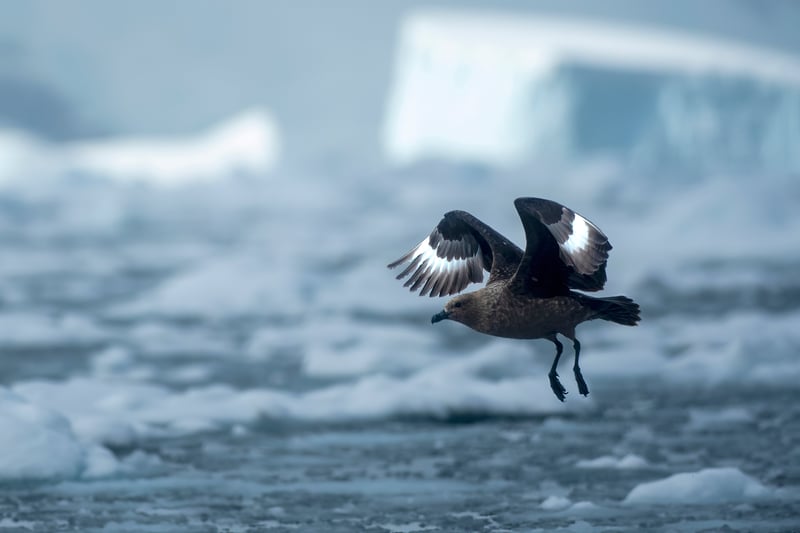
Bird Flu Jumps to Mainland Antarctica as Scientists Fear for Penguin Colonies
Blog
Two skuas, scavenging birds, were found dead from the H5N1 virus making this the first time bird flu has reached mainland Antarctica.
While suspected cases of H5N1 bird flu have been reported in brown skua, south polar skua, and kelp gull in Hope Bay on the Antarctic peninsula, two dead skuas were confirmed to have the H5N1 virus in February 2024. The bodies of the skuas infected with bird flu were found near the Primavera Base, the Argentinian scientific research station, and are the first confirmed cases of avian flu on the Antarctic mainland.
This highly infectious disease has continued to devastate wild and farmed animal populations through migratory birds. The virus is now threatening Antarctica’s most unique wildlife populations and has jumped to every continent except Australia.
In early February, a king penguin died from suspected bird flu and at least one gentoo penguin was confirmed dead from H5N1 on the Falkland Islands, stoking fears from scientists that it would jump to the mainland amid remote populations of these wild animals currently clustering together in large numbers for breeding season. More than 35 gentoo penguin chicks on the Falklands had either died from bird flu or were exhibiting symptoms.
Since penguins in the Antarctic region live in a more remote area of the world, with natural barriers that separate them from other continents, this is the first time the species has been exposed to avian influenza meaning they likely don’t have immunity. This could spell disaster for these iconic animals, who are already at risk due to climate change according to the US Fish and Wildlife Service.
This tragic news comes just weeks after the Alaska Department of Environmental Conservation confirmed the death of a polar bear from Highly Pathogenic Avian Influenza (HPAI)—the type of H5N1 that causes more severe disease—in the Arctic.
More than 500,000 seabirds have died in South America—with pelicans, boobies, cormorants, and penguins most heavily impacted—while elephant seals have been dying en masse in the Antarctic since the virus appeared in the region.
Ed Hutchinson, a molecular virologist at the MRC-University of Glasgow Centre for Virus Research, told The Guardian:
“The arrival of this H5N1 virus in the Antarctic towards the end of last year rang alarm bells because of the risk it posed to wildlife in this fragile ecosystem. And while it is very sad to hear reports of penguins dying … it is unfortunately not at all surprising.”
Highly Pathogenic Avian Influenza continues to spread rapidly throughout the globe, killing millions of birds and thousands of wild mammals in the process.
In fact, Finland slaughtered over 125,000 mink and foxes in August 2023 due to fears bird flu would mutate and more effectively jump to humans after it was reported in more than two dozen Finnish fur farms in July and August 2023 alone. Concerns about the risks mink farms pose in the spread of zoonotic diseases is one reason American legislators have introduced the Mink VIRUS Act to end mink farming for fur in the US.
Highly Pathogenic Avian Influenza (HPAI) is extremely contagious among birds raised in factory farms, like chickens, geese, turkeys, and ducks. Due to the massive number of animals crowded into factory farms, diseases such as HPAI H5N1 can thrive, leading to millions of domestic birds being killed to stop the spread of an outbreak.
As of late November, more than 8.1 million factory-farmed birds were killed in Ohio due to bird flu concerns, according to USA Today. That, alone, has cost the US government over $660 million. Nationwide, more than 65 million individual birds have been slaughtered since 2022 in an effort to stop or slow the spread of bird flu.
Factory farms, whether they’re for food or fur, are breeding grounds for diseases. Many scientists predict they could be ground zero for a future global pandemic.
Now more than ever, we need to rethink the way we interact with all animals.
By shifting to more sustainable and kinder practices, such as reducing or eliminating our consumption and use of animals, we can end the largest source of animal cruelty on the planet: factory farming.
But the animals we share this planet with can’t wait. Take action to ban factory farming right now.